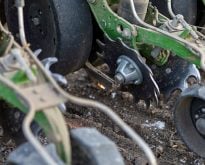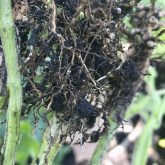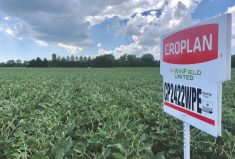Glacier FarmMedia – It was just over 10 years ago that Marla Riekman started getting the phone calls on a new soil issue.
The provincial soil specialist with Manitoba Agriculture and Resource Development suddenly started to hear from growers in the Red River Valley who were alarmed at the appearance of salinity in places they’d never seen it before.
While the heavy clay soils of the area are no strangers to mild salinity, this was something different, likely showing up because growers were planting more soybeans, which is a crop that can show issues more readily.
Read Also

Could crop sharing be a viable option for your farm?
Crop sharing could be a good option for young and beginning farmers.
“The reality is those soils in the Red River Valley are heavy clay soils,” she said. “There’s mild salinity everywhere and it started rearing its ugly head when we started growing more soybeans in our crop rotations. They’re very sensitive to salinity and, when we’re talking about things like salinity or IDC (iron deficiency chlorosis), we’re talking about water-type problems.”
Soybean have proven to be an indicator for water problems and frequently it’s a combination of a number of different factors. Part of the problem is soil compaction and how it affects the way water moves through soil. For example, we see some of these effects in places like wheel tracks or in headlands that take a lot of compaction because of the constant wheel traffic where machinery turns.
“We know that this can cause more of those smaller compressed pores so we’ll have less internal drainage and more ponding of water during wet periods,” Riekman said. “If we have a loss of proper water flow through the soil, we start to see some of these problems become larger than they would have been in their natural state.”
Salinity is a good example of this. Salinity, a higher level of salts in the soil moisture, makes it more difficult for plants to gather and absorb soil nutrients. Although this may seem like a salt problem, it’s the physical interaction of soil and water that puts the salt there.
“Yes, those salts are there, they come up from below, but the reason why those salts fester and cause problems is because of the water movement in the soil,” Riekman said. “If we have a water table that’s near the surface and more upward movement of water than downward movement, we have a salinity problem.”
The other part of it is dry weather such as the last several summers. When the surface soil moisture evaporates the capillarity action in the soil draws more saline water from the water table up through the micropores. Then more of it evaporates and leaves the salt behind. A good soaking from a gentle snowmelt or prolonged rain will help carry salts back down if there is free transit back to the water table.

“Compaction may impede that downward movement but encourage capillary rise and this may be most noticeable in compacted headlands,” Riekman said. “We’re going through this period where upward movement of water is more prevalent and we’re not seeing that downward precipitation and leaching of the salts back down and deeper into the soil profile. In general, salinity always follows behind changes in precipitation.”
Iron deficiency chlorosis is another water-related problem for soybean and it’s a bit more complex. It’s partly poorly drained soils and a little too much water but it’s also a product of high-lime soils, elevated soil nitrates and herbicide stress among others.
“There’s a lot of different factors that affect iron deficiency chlorosis and so that needs to be considered,” Riekman said. “Often I see this iron deficiency show up along drains, along wetter areas in the field but really, especially along headlands and, again, these compacted regions of the field will show the problem worse.
It’s that poor drainage again and this could be because of the ratio of micropores to macropores. When you have poor drainage, high carbonate or free lime in the soil actually dissolves in soil water and affects the root’s ability to acidify the area around the root zone. That actually makes it harder for iron uptake by the plant.
“So we see these things come along following a wet period,” Riekman said. We’ll see the crop yellow up for a little bit in the new growth and it will grow out of it as the soil dries out, but the soil doesn’t always dry out as quickly in the headlands so we end up seeing these problems show up again in that new growth.”
You could use an iron chelate (EDDHA) in furrow while you’re fertilizing. This is expensive though so you’d want to do that in areas where you know the risk is high. The better option would be to select a soybean variety that tolerates higher-risk conditions.
“You want to look at these different ratings where they’ll group them based on say a tolerant, semi-tolerant and susceptible grouping. You want the most tolerant crops,” Riekman said. “If you know that IDC is one of those problems that you have and you know that compaction might be compounding the risk in certain areas of the field make sure that you’re thinking about varietal choices to be able to combat some of this.”
– This article was originally published at the Manitoba Co-operator.















